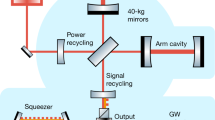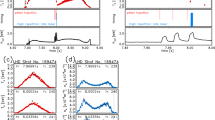Abstract
SOME time ago, Conway1 suggested the use of a special technique for radio astronomical observations at centimetre wavelengths. It should eliminate the influence of radiation fluctuations from the troposphere on the sensitivity of the radio telescope. This communication reports the success of tests at wavelengths of 9.5 mm and 2 and 6 cm on a 140 ft. telescope. The radiometer is switched between two feed horns, both located close to the focal point of the paraboloid, and the difference in power is recorded. Two similar beams are projected on the sky separated by some angle. Close to the antenna (in the Fresnel region) the cylindrical beams overlap partially. By keeping the source in one of the beams only, we can measure its flux density and simultaneously cancel the atmospheric noise, because it enters the two overlapping beams. The method is restricted to observations of sources with angular extent less than the beam separation.
This is a preview of subscription content, access via your institution
Access options
Subscribe to this journal
Receive 51 print issues and online access
$199.00 per year
only $3.90 per issue
Buy this article
- Purchase on Springer Link
- Instant access to full article PDF
Prices may be subject to local taxes which are calculated during checkout
Similar content being viewed by others
References
Conway, R. G., Nature, 199, 1177 (1963).
Epstein, E. E., Astrophys. J., 142, 1282, 1285 (1965).
Author information
Authors and Affiliations
Rights and permissions
About this article
Cite this article
BAARS, J. Reduction of Tropospheric Noise Fluctuations at Centimetre Wavelengths. Nature 212, 494–495 (1966). https://doi.org/10.1038/212494a0
Issue Date:
DOI: https://doi.org/10.1038/212494a0
This article is cited by
-
Outbursts of Cygnus X-3 observed at 1.3 and 3.3 mm wavelengths
Nature (1986)
-
Detection of Radio Emission from P Cygni
Nature Physical Science (1973)
-
Sky noise and the sensitivity of earth-based radiotelescopes
Radiophysics and Quantum Electronics (1968)
-
Variations in the Flux Density of Some Quasi-stellar Sources
Nature (1967)
Comments
By submitting a comment you agree to abide by our Terms and Community Guidelines. If you find something abusive or that does not comply with our terms or guidelines please flag it as inappropriate.



